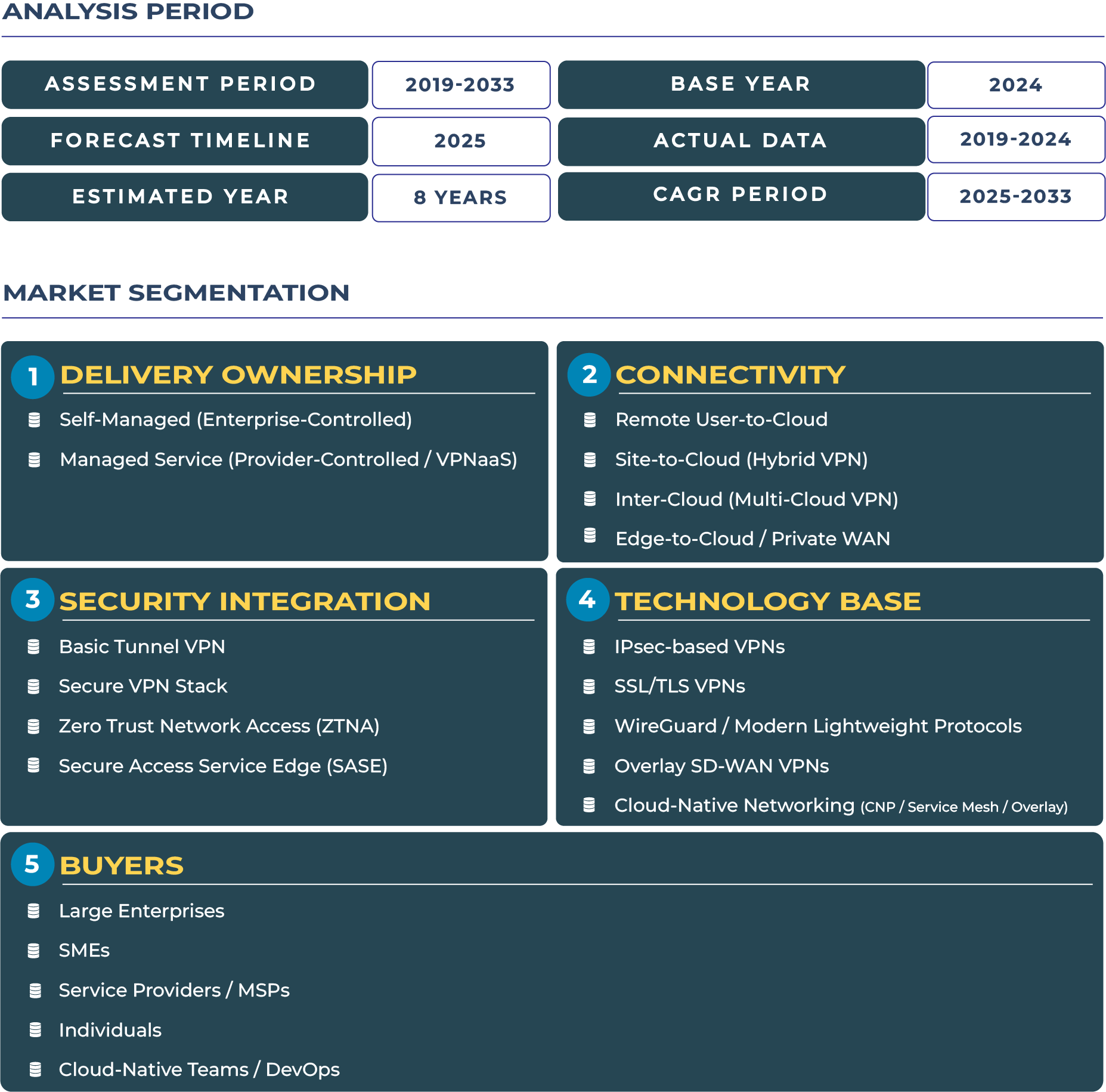Report Format:
![]()
![]() |
Pages: 110+
|
Pages: 110+
US Cloud VPN Market Outlook: Driving Innovation and Secure Connectivity for Enterprises
The US Cloud Virtual Private Networks (Cloud VPN) market in 2025 is projected to reach USD 4.99 billion, with expectations to grow to USD 17.06 billion by 2033, reflecting a CAGR of 16.6% from 2025 to 2033. The United States has emerged as a hub of cloud VPN innovation, fueled by a robust ecosystem of enterprise-grade SASE and Zero Trust Network Access (ZTNA) solutions. High enterprise security expenditure, combined with large-scale cloud-native migrations led by hyperscalers, has created a fertile environment for advanced VPN and secure access deployments. Regulatory compliance and federal cybersecurity initiatives further enhance adoption, positioning the US market as a leading example of secure enterprise digital transformation.
Drivers & Restraints: Strategic Forces Shaping the US Cloud VPN Market
Driving Factors: Hyperscaler Cloud Migrations and Enterprise Security Spend
Rapid adoption of cloud-native architectures and large-scale migrations to hyperscaler platforms are key growth drivers. Enterprises, especially in finance, healthcare, and government sectors, demand high-performance secure access solutions that reduce operational complexity and enhance compliance. The presence of leading VPN and SASE vendors headquartered in the US accelerates adoption, providing enterprises with integrated solutions that combine VPN, ZTNA, and SASE capabilities. These integrated offerings simplify management while delivering high levels of security and visibility across hybrid and multi-cloud environments.
Restraints: Compliance Complexity and Talent Shortages
Despite strong market growth, challenges remain. The US market is heavily regulated, with complex federal and state compliance requirements that can delay VPN deployments and procurement cycles. Additionally, a shortage of skilled network and security professionals affects the timely implementation and management of advanced Cloud VPN solutions. These factors necessitate strategic vendor partnerships and managed service adoption to mitigate operational risk.
Trends & Opportunities: Driving the Next Wave of Cloud VPN Evolution
Emerging Trends: Enterprise ZTNA Adoption and Cloud Provider Marketplaces
The adoption of ZTNA frameworks is rapidly increasing as enterprises pivot from traditional VPNs to identity-aware access models. Cloud provider marketplaces are also emerging as key distribution channels for managed VPN and SASE offerings, facilitating streamlined procurement and deployment. Observability tools and performance SLAs are gaining importance, ensuring low-latency, high-availability connectivity for mission-critical applications.
Opportunities: Direct Enterprise SASE Deals and Regulated Industry Focus
Opportunities abound for vendors in providing direct SASE deals to large enterprises, particularly in federally regulated sectors such as finance and healthcare. Edge Points of Presence (PoPs) deployment enhances performance for latency-sensitive applications, while managed services tailored for small and medium-sized businesses (SMBs) open additional revenue streams. Bundling security services like FWaaS, CASB, and DLP with VPN solutions enhances value propositions and supports customer retention.
Competitive Landscape: Leading Players and Strategic Developments
Key players in the US Cloud VPN market are advancing solutions through innovation, partnerships, and cloud-native capabilities. Palo Alto Networks expanded Prisma Access with inline DLP and identity controls in 2025, strengthening ZTNA and SASE capabilities. Cisco enhanced AnyConnect with integrated ZTNA and cloud management upgrades to evolve legacy VPN clients into identity-aware access platforms. OpenVPN launched a new managed cloud offering for US SMBs via AWS Marketplace, providing turnkey VPNaaS solutions. These strategic initiatives focus on compliance, integrated security, and enterprise-grade performance to support the evolving needs of US organizations.
Conclusion: Securing the Future of US Cloud VPN Ecosystem
The US Cloud VPN market continues to advance, driven by innovation, regulatory compliance, and enterprise demand for secure and high-performance connectivity. The growth trajectory is underpinned by SASE and ZTNA adoption, cloud-native VPN deployments, and strategic vendor partnerships. Enterprises benefit from enhanced operational efficiency, improved security posture, and simplified hybrid-cloud management. Stakeholders who leverage these trends and strategically deploy integrated solutions are well-positioned to thrive in the competitive US Cloud VPN landscape.







